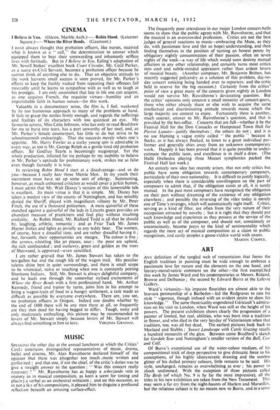ART
ANY definition of the tangled web of romanticism that forms the English tradition in painting must be wide enough to embrace a passionate love for nature and the elements on the one hand, and literary-moral-satiric comment on the other—the first exemplified this week by James Ward and his contbmporaries at Messrs. Roland, Browse and Delbanco ; the second by Edward Burra at the Lefevre Gallery.
Ward's virtuosity—his impasto flourishes are almost akin to the bravura penmanship of a Barbedor—led the Redgraves to rate his style " vigorous, though imbued with an evident desire to show his knowledge." The same theatricality engendered Gericaules admira- tion on his visit to London, when Ward was still at the height of his powers. The present exhibition shows clearly the progression. of a painter of limited, but real, abilities, who was born into a tradition in flower, and who died in the very heyday of Victorianism when that tradition, too, was all but dead. The earliest pictures look back to Morland and Stubbs ; Sunset Landscape with Cattle Grazing recalls a hundred monarchs of the _glen. Between come Bradford's sketch for Gordale Scar and Nottingham's smaller version of the Bull, Cow and Calf.
Of Burra's exceptional use of the water-colour medium, of his compositional trick of deep perspective to give dramatic force to his conceptions, of his highly idiosyncratic drawing and the sombre glitter of his dulled primary colours, little remains to be said. His style, unchanged, remains as overwhelming as ever ; his power to shock undimmed. With the exception of three pictures called The Birds (of which No. 9 is by far the most impressive), all the titles in his new exhibition are taken from the New Testament. This may seem a far cry from the night-haunts of Harlem and Marseilles, but the religious subject is by no means new to Burra, and in a sense
all his work of the last fifteen years has had a religious undertone. Blood, violence, terror remain. What magnificent stained-glass windows he could design !
Further evidence of the quite startling revival of interest in sculpture is shown by the exhibition of some 150 pieces by British artists, spaciously presented by the International Faculty of Arts at 45 Park Lane. More catholic than the Royal Academy or the Institthe of Contemporary Arts, this is a deliberate attempt to embrace as wide a diversity of styles as possible. The ease with which the extremes live together is perhaps partly due to the popularity of wood as a medium. Names are famous and unknown. There are stodgy incompetences and glib stylisations that too loudly proclaim an intrinsic poverty of thought, feeling and observation, but the general level remains high. Among the more notable things are Epstein's bronze of Sandra Dome, Soukop's elm Standing Figure, F. E. MacWilliam's abstract, and R. B. Claughton's Man with Horse. Even if Battersea continues its biennial excitements, there is room for an exhibition of this kind every year.
M. H. MIDDLETON.











































 Previous page
Previous page